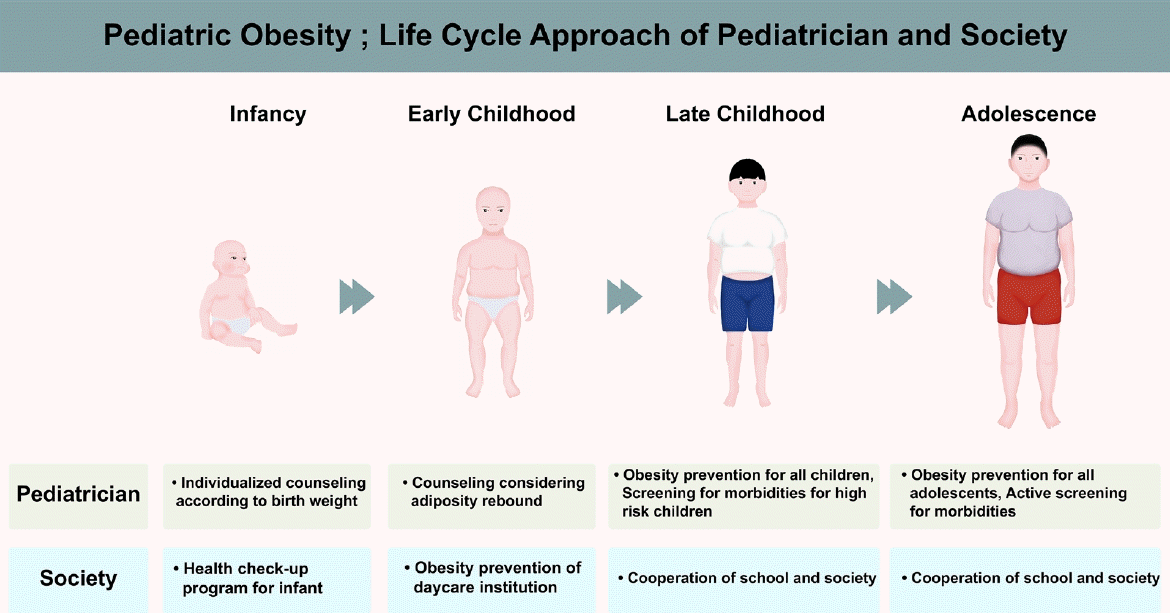Pediatric obesity: life cycle approach of pediatrician and society
Article information
Key message
• With the emerging epidemic of pediatric obesity, many endocrine comorbidities classically seen in adulthood are surfacing much earlier in life.
• Appropriate obesity counseling and education should be provided from infancy to adolescence.
• Managing pediatric obesity may require school and society involvement.
The prevalence of obesity in children has increased significantly during the past few decades. The related behavioral and environmental factors have been negatively impacted by the coronavirus disease 2019 (COVID-19) pandemic, including losses of daily routines. Obesity in children may further increase in the future, and some countries have already reported increased pediatric obesity rates [1].
At this point, obesity counseling by age group is necessary (Fig. 1). Small for gestational age (SGA) and large for gestational age (LGA) size at birth are associated with body adiposity and metabolic complications throughout life [2]. Children who are born SGA also experience weight acceleration, while those born LGA experience an absence of weight deceleration; both states have been associated with future obesity [3]. Many observational studies have suggested that rapid weight gain in infancy (upward centile crossing) increases an individual’s long-term risk of obesity [4]. The optimal infant weight gain pattern may differ depending on birth weight regardless of preterm versus term status. Pediatricians should consider birth weight, a prenatal determinant of obesity and catch-up and -down growth, in obesity counseling.
Adiposity rebound (AR) in early childhood is a risk factor for obesity and metabolic derangement in adolescence and adulthood. Body mass index rapidly increases during the first year of life, then subsequently decreases and reaches a nadir at around 6 years of age. Thereafter, it increases again throughout childhood, a phenomenon termed AR [5]. The close relationship between an early AR timing and later obesity is well known [5]. Moon [6] recently reported that a late AR timing was significantly associated with a decreased risk of developing obesity and an increased probability of reversing obesity among kindergarteners. Therefore, pediatricians should be able to educate parents and children on the dangers of an early AR.
Childhood obesity is caused by a combination of genetic and epigenetic factors as well as environmental and behavioral factors such as nutrition and physical activity. Since school-aged children spend a lot of time at school, it is necessary to create a social environment and atmosphere in which they are allowed to move. Schools can play a role in preventing childhood obesity by serving healthy meals with adequate calories and nutrients, providing nutrition education that encourages healthy food selection, offering opportunities for physical activity, and creating environments that model healthy behaviors [7]. Obesity management at this time requires school and societal involvement. In this age group, education on obesity prevention should be provided to children attending pediatric clinics whenever possible. In addition, a national health insurance policy should be implemented.
Growing evidence shows that the prevalence of severe obesity is increasing in adolescents in several countries, including Korea [8]. The spontaneous remission of obesity to a healthy weight is rare; at least 90% of obese adolescents will be overweight or obese in young adulthood [9]. Adolescence represents a critical time to set one’s habits for long-term health [10]. Therefore, preventing and treating adolescent obesity are important.
The increasing prevalence of childhood and adolescent obesity is associated with an increase in comorbidities previously identified in the adult population, such as type 2 diabetes mellitus, hypertension, nonalcoholic fatty liver disease, and dyslipidemia [11]. In a recent issue of Clinical and Experimental Pediatrics, Lee and Kim [12] reviewed the endocrine comorbidities of pediatric obesity. The authors showed increasing trends of endocrine comorbidities of obesity and emphasized that maintaining a healthy weight and preventing obesity are of critical importance. The high rates of childhood and adolescent obesity and related endocrine comorbidities, which were recently exacerbated by the COVID-19 pandemic, require awareness of obesity prevention,screening for comorbidities, and developing treatment strategies for high-risk children.
In conclusion, with the emerging epidemic of pediatric obesity, many endocrine comorbidities classically seen in adulthood are surfacing much sooner in life. Appropriate obesity counseling and education should be provided from infancy to adolescence.
Notes
Conflicts of interest
No potential conflict of interest relevant to this article was reported.

